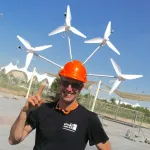
Master of Science Communication
Overview
Leadership and impact in science depend on communication
- Technical scientific skills and knowledge are essential to modern science. But to really have impact in science and drive innovation, aspiring leaders need to know how to communicate and engage with the wide range of stakeholders - including funders, other research disciplines, policy makers and community groups - connected with any project.
- “Our Master of Science Communication provides graduates with the knowledge and skills needed for this task, offering a unique combination of research, cutting edge coursework on a wide range of crucial science communication topics, and work-integrated learning opportunities with key science and science communication organisations.
- “The program is taught by some of Australia’s leading science communication researchers and practitioners, and can transform careers in science, advocacy, media and government.
For Australian domestic students, Commonwealth Supported Places (CSP) are available for this program
Key facts
- 2 years full time
- Semester 1 (Feburary) & 2 (July) intake
- #1 in Australia for graduate employability (Times Higher Education)
- Commonwealth Supported Places available
- Credit available for up to one year of previous study
Testimonials

Skye Zhu
“This program taught me has taught me to be more engaging in the way I communicate. Before, I would use lots of technical terms to show how much I knew about science. Now I use plain English so the audience can understand me, and I include stories to relate the science to their daily lives.”

Tiah Penny
I really value the balance between theory and practical learning in the Master of Science Communication. The placement with Mulligan's Flat has been a great experience to directly contribute to environmental science communication – spending time in nature, working alongside passionate people, and increasing awareness and appreciation of the Yellow Box Grassy Woodlands and its inhabitants with others. 10/10 experience!
Careers
Our Master of Science Communication can transform careers in science: leading to greater impact in the scientific world, or communicating science in the advocacy, media and policy sectors.
Many graduates have found careers as communication officers for scientific organisations such as The Commonwealth Scientific and Industrial Research Organisation (CSIRO), government departments, universities, businesses, NGOs, or in the media. Some have set up science media businesses or consultancy firms. Others work in centres for informal science learning across the world, such as science centres and museums.
The Master's research project provides an opportunity to produce assessment tailored to the needs of particular organisations or employment sectors, and most coursework assessment can also be tailored to students' interests, areas of expertise, and career ambitions.
The Australian National University has been ranked as the top university for graduate employability in Australia in the Global University Employability Ranking 2023-24. As a student at ANU, you gain access to the ANU CareerHub – an online career development and employability tool that includes a jobs board and careers resources. You also have access to drop-in chats with a career consultant and to attend our career fairs to meet potential employers.
Learning experience
Fees & scholarships
Scholarships
Whether you are looking for financial support to start your studies at ANU or help to move away from home for the first time, we have scholarship opportunities for you and your situation.
Convenors

Dr Graham Walker

Graham’s teaching, research and engagement works at the interface of science communication and informal STEM learning, emotion and motivation, international capacity building and co-development, and communication of social and environmental issues, particularly in settings like science centres, science shows and hands-on workshops.
How to apply
Understand the how to apply steps
Visit the international postgraduate applications page to prepare for your application to ANU.
International postgraduate applicationsUnderstand the how to apply steps
Visit the domestic postgraduate applications page to prepare for your application to ANU.
Domestic postgraduate applications




